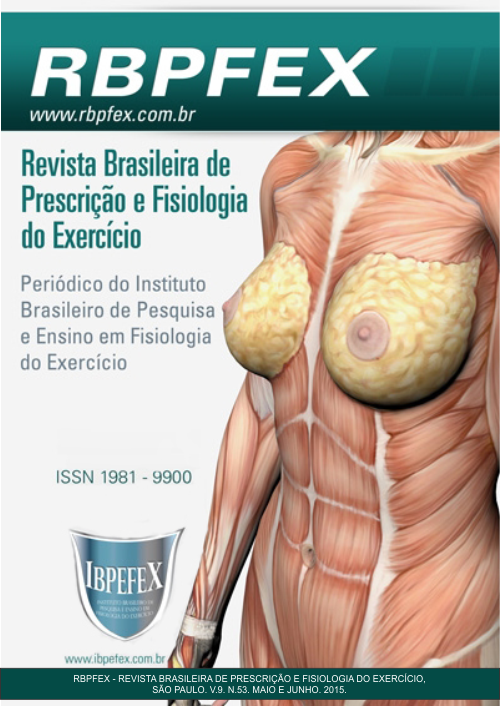Judo practice may not be critical to gain strength and flexibility in young
Abstract
This study aimed to verify and compare the levels of flexibility and hand-grip strength (HGS) of young judo athletes and non-athletes. 69 volunteers, of both sexes, aged between 10 and 13 years old, being 9 judo athletes and 60 no athletes. Flexibility was measured using the sit and reach test (Wells Bench), and the HGS was by an analogic dynamometer (JAMAR®). The results of HGS (athletes = 26.2 ± 4.64 kg/f; non-athletes = 23.03 ± 6.07 kg/f) and flexibility (athletes = 28.50 ± 6.46 cm; non-athletes = 24.29 ± 6.86 cm) did not show significant differences between the groups. Therefore, we conclude that young athletes of Judo have the same level of HGS and flexibility than non-athletes.
References
-Bu, B.; Haijun, H.; Yong, L.; Chaohui, Z.; Xiaoyuan, Y.; Singh, M.F. Effects of martial arts on health status: A systematic review. Journal of Evidence‐Based Medicine. Vol. 3 Num. 4. 2010. p. 205-19.
-Gonçalves, J.A.C.N. Nível de aptidão física de judocas da categoria infanto e pré-juvenil da cidade de trindade. Artigo apresentado no II Seminário de Pesquisas e TCC da Faculdade União de Goyazes. 2011.
-Gonçalves, L.C.O.; Benassi, R.; Oliveira, A.L.B. Valores de referência de força de preensão manual para homens praticantes de judô. Revista Brasileira de Prescrição e Fisiologia do Exercício. São Paulo. Vol. 6. Num. 32. 2012.
-González-Gross, M.; Gómez-Lorente, J.J.; Valtueña, J.; Ortiz, J.C.; Meléndez, A. The healthy lifestyle guide pyramid for children and adolescents. Nutrición hospitalaria. Vol. 23. Num. 2. 2013. p. 159.
-Guedes, D.P.; Guedes, J.E.R.P. Manual prático para avaliação em educação física. São Paulo. Manole. 2006.
-Kwon, S.; Burns, T.L.; Levy, S.M.; Janz, K.F. Which contributes more to childhood adiposity-high levels of sedentarism or low levels of moderate-through-vigorous physical activity? The Iowa Bone Development Study. The Journal of pediatrics. Vol. 162. Num. 6. 2013. p. 1169-74.
-Melo, J.P.D.; Dias, J.C.N.D.S. Do jogo e do lúdico no ensino da educação física escolar. Licere (Online). Vol. 13. Num. 1. 2010.
-Metter, E.J.; Talbot, L.A.; Schrager, M.; Conwit. R. Skeletal muscle strength as a predictor of all-cause mortality in healthy men. The Journals of Gerontology Series A.Biological Sciences and Medical Sciences. Vol. 57. Num. 10. 2002. p. 359-365.
-Nasri, R.; Hassen Zrour, S.; Rebai, H.; Fadhel Najjar,M.; Neffeti, F.; Bergaoui, N.; Tabka, Z. Grip strength is a predictor of bone mineral density among adolescent combat sport athletes. Journal of Clinical Densitometry. Vol. 16. Num. 1. 2013. p. 92-97.
-Newman, A.B.; Kupelian, V.; Visser, M.; Simonsick, E.M.; Goodpaster, B.H.; Kritchevsky, S.B.; Harris, T.B. Strength, but not muscle mass, is associated with mortality in the health, aging and body composition study cohort. The Journals of Gerontology Series A. Biological Sciences and Medical Sciences. Vol. 61. Num. 1. 2006. p. 72-7.
-Pate, R.R.; Pratt, M.; Blair, S.N.; Haskell, W.L.; Macera, C.A.; Bouchard, C.;Wilmore, J.H. Physical activity and public health: a recommendation from the Centers for Disease Control and Prevention and the American College of Sports Medicine. Jama. Vol. 273. Num. 5. 1995. p. 402-7.
-Rantanen, T.; Harris, T.; Leveille, S.G.; Visser, M.; Foley, D.; Masaki, K.; Guralnik, J. M. Muscle strength and body mass index as long-term predictors of mortality in initially healthy men. The Journals of Gerontology Series A. Biological Sciences and Medical Sciences. Vol. 55. Num. 3. 2000. p. 168-73.
-Santaliestra-Pasías, A.M.; Rey-López, J.P.; Moreno Aznar, L.A. Obesity and sedentarism in children and adolescents: what should be bone. Nutr Hosp. Vol. 28. Num. 5. 2013. p. 99-104.
-Simão, R.; Lemos, A.; Salles, B.; Leite, T.; Oliveira, É.; Rhea, M.;Reis, V.M. The influence of strength, flexibility, and simultaneous training on flexibility and strength gains. The Journal of Strength & Conditioning Research. Vol. 25. Num. 5. 2011. p. 1333-8.
-Taddei, A.C. Prevalências de sobrepeso, obesidade e hábitos de vida associados ao risco cardiovascular em alunos do ensino fundamental. Rev Assoc Med Bras. Vol. 52. Num. 2. 2006. p. 118-24.
-Witvrouw, E.; Danneels, L.; Asselman, P.; D’Have, T.;Cambier, D. Muscle flexibility as a risk factor for developing muscle injuries in male professional soccer players a prospective study. The American Journal of Sports Medicine. Vol. 31. Num. 1. 2003. p. 41-6.
Authors who publish in this journal agree to the following terms:
- Authors retain the copyright and grant the journal the right of first publication, with work simultaneously licensed under the Creative Commons Attribution License BY-NC which allows the sharing of the work with acknowledgment of the authorship of the work and initial publication in this journal.
- Authors are authorized to enter into additional contracts separately for non-exclusive distribution of the version of the work published in this journal (eg, publishing in institutional repository or book chapter), with acknowledgment of authorship and initial publication in this journal.
- Authors are allowed and encouraged to post and distribute their work online (eg, in institutional repositories or on their personal page) at any point before or during the editorial process, as this can bring about productive change as well as increase impact and impact. citation of published work (See The Effect of Free Access).






